
Micro-nuclear plants for local power
A large off-grid community can be established anywhere with full power supply, now company launches mini-nuclear-power plant…

A large off-grid community can be established anywhere with full power supply, now company launches mini-nuclear-power plant…
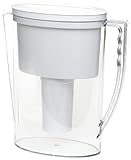
More evidence emerges that tap water contains pharmaceuticals. So maybe bottled water is better after all?…
Wow, my eyes have been opened, about bleach that is! One of the things I stocked up on before my move was Clorox bleach, mainly for use in disinfecting and cleaning, but also as a water purifier if need be, well I just found out that bleach has a very definate shelf life, it’s 6 months, yes, I said 6 months! It is recommended that you replace or rotate your liquid bleach every 3 months. That’s so scary because I have 3 or 4 large jugs of bleach that I haven’t even opened yet, these were purchased before December, now it’s September, so it seems that my supply of bleach may not be as strong as I thought it would be.
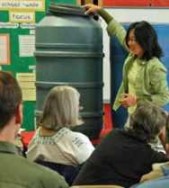

Tara gives lessons on free water Bill Gates Foundation has just budgeted $4m to investigate the potential of rainwater harvesting in the third world. But what about the first world?
America is rapidly catching on to water caching, as rainwater harvesting is also known.
In the Bay Area, Tara Hui, a rainwater campaigner, climbed under her deck, nudged past a cluster of 55-gallon barrels and a roosting chicken, and pointed to a shiny metal gutter spout.
“See that?” she said. “That’s where the rainwater comes in from the roof.”…
I found more information on the Rabbit Water Filter, here are the links, I might go back in and copy some of the information from their site to here, but for now, here are the links:
https://www.pottersforpeace.org
Wretha
Close this window Jump to comment form


A Typical MH set-up on a river. If you have a stream, you have a renewable, natural source of energy that, if done right, can have little to no impact on the environment around you. Using water as a power source goes back to ancient times. Roman was known to power their empire on it. There is abundant supply of streams and rivers that criss cross the US making micro-hydro power feasible. That is especially true in remote wooded areas where other natural energy, such as solar or wind, would be harder to integrate into the existing environment.
A micro-hydro power system needs a sufficient amount of falling water to be available in order to be feasible. Mountainous and hilly sites are best suited for this type of renewable energy. To figure out the amount of power that is possible from your water source you need to know the head and flow of your stream. The head is the vertical distance of the falling water. While the flow is the speed the water flows at.
A micro-hydro power site usually falls into either a low or high head category. A higher head is better due to needing less water to produce energy as well as the equipment being cheaper than those with a low head. A change in elevation that is less then 10ft (3 meters) is categorized as low head. Anything with a vertical drop less than 2ft (.6 meters) will make a micro-hydro power system not possible. Though if you have as little as 13” of water depth you are able to utilize a submersible turbine, which was originally designed to power scientific instruments being towed behind exploration ships.
There is both a gross and net head that needs to be calculated. The gross head is the vertical distance between where the water enters the penstock, pipes that convey the water under pressure, to where the water exits the turbine. You calculate your net head by subtracting the friction that is caused by the piping and the turbine itself.
While the best way to get an accurate gross head is to have a professional survey of your desired site, you can do a rough estimate yourself. You can use the hose-tube method by taking stream-depth measurements across the width of the water supply you intend to use. Once you know where you intend to place the beginning of the penstock and the turbine you can follow the direction below.
The Hose-Tube Method is done by:
…
- Make sure you have all supplies needed: Someone to help, 20ft to 30ft (6 to 9 meters) small diameter garden hose, Funnel, Measuring tape or yardstick
- Stretch the hose down the water channel from desired entrance to the penstock (usually the highest elevation)
- One person place the funnel into the hose upstream as close to the surface as possible
- At the downstream position

Managing water has become a growing concern. Though the Earth has abundant water only about 1% is actually available for human use. So taking into account that population and the demand for usable water will be increasing in the future while the supply will remain constant, a decision to increase efficiency by consumers at large was made.
The average American household uses about 100,000 gallons of water a year. And some of that is waste. That adds up to about 900 billion gallons of wasted water from just American households. Off-grid or not – give your bathroom a high-efficiency makeover, and save more than 11,000 gallons annually (over 10%).
Installing WaterSense toilets and faucets or faucet accessories reduces water bills, and the upgrade could pay for itself in a few years and continue to save water and money for years to come.
Replacing all the inefficient toilets in the US alone with WaterSense labeled toilets the US nation could save 640 billion gallons of water that is literally being flushed away every year.
The program works by promoting water efficiency and the products, programs, and practices that can be used every day by people. It was open for public input on May 22, 2008 when the draft specification for water-efficient single family new homes was released. These are open for public input until July 21, 2008. So even though products will be hitting the shelves and programs will be starting soon the complete specifications for this program will not be finalized until later.
Programs and products that meet the performance and efficiency criteria of this EPA program will be allowed to carry the WaterSense label.This can be a big help for those who are remodeling, or trying to cut down on water use for either drought or monetary reasons. With this new label you are assured that these products will perform well, help you save money, and even help to encourage move innovation in the creation of even better performing water products. You can visit the EPA website to see a list of water-efficient products
They have designed many of the products to not require a change in your lifestyle, just in the water you use. Changing faucets, toilets, landscaping devices, etc. is all that is needed to make a positive impact on both your wallet and the environment. For those who live in drought prone areas that can make a big difference if as a community you change over to these new easy to identify products.
Growing communities are now faced with the problem of not only needing an increased supply but the infrastructure to support it. The WaterSense program is also designed to help these communities to build that infrastructure in the most efficient way. This is not a concern for the average citizen but knowing that this program is designed to help the community at large as …
The Australian National University (ANU) scientist Tony Flynn has developed a process to create water filters from commonly available materials. The materials need to also be fired, which can be done without a kiln or other western technology, by using common manure.
An estimated 80% of all sickness in this world can be attributed to unsafe water and sanitation according to the World Health Organization (WHO). That can be seen in the annual 1.5 billion episodes of diarrhea in children under the age of 5, with about four million of those being fatal.
Since historically water filters have had to be imported to developing nations, which means increased cost and reduced availability for the populace. With the new filter design made from common place materials available in even the most remote places.
“These filters are a hollow ceramic vessel filled with charcoal. They are intended to filter out suspended silt and bacteria. However, at around $US5 each, they’re too expensive for individuals in many developing communities to consider purchasing,” stated Mr Flynn. “They are very simple to explain and demonstrate and can be made by anyone, anywhere. They don’t require any Western technology. All you need is terracotta clay, some used coffee grounds or tea leaves, a compliant cow and a match,” Mr Flynn continued “Everyone has a right to clean water, these filters have the potential to enable anyone in the world to drink water safely.”
Filter production is simple:
Since using a potters kiln can take up to eight to nine hours to achieve the temperatures needed, which can be achieved using this method in a hour or less. Also with the expensive of such a kiln being prohibitive to most people, this is an excellent method anyone can make use of. Especially since no additional technology, or added insulation is needed being able to drink safe, filtered water water in almost any location on the planet. As long as water, manure, red/yellow clay and human organic debris you can make a filter that traps pathogens.
This design is purposely not being patented in a hope that it can be freely used around the world. Their belief that even third world countries should have the ability to have clean safe drinking water.
When the …
Being tankless in heating your water is an easy, if somewhat costly, upgrade that you can see immediate benefits from. Costs can vary from about $150 for point of use water heater to household ones starting about $450 going up to $1000 or more for top of the line models. Point of use models install directly under the water fixture which also means less heat loss and you can convert your water heating system slowly one water fixture at a time. But since most houses have at least two sink and a tub you will already go over the cost of the cheapest whole house tankless system. On the plus the up front cost can be spread out over time, and for smaller places such as boats, RV’s, campers, etc. it might just be what you are looking for.
The average household spends $50 or more a month just to keep hot water at the ready. This means that the hot water is heated and then stored in it’s tank to wait for use. Just like anything else that id hot and left to sit heat loss happens and then it needs to be re-heated, which just starts the cycle over again. Once the water is used the cycle is again in place till that water is used, and so on. That is a lot of wasted energy you are paying for just to have the convenience of on demand hot water. At that hot water is finite since the average tank system holds about 40 galleons and tankless can supply an infinite supply. Chyanging over to a tankless system lets you use as little or as much hot water as you need without the worry over running out or heating more than needed.
The lifespan of a tankless water heater, 20+ years, is almost double that of a convential water heater, 8 to 12 years, Also a tankless system is serviceable while most tank water systems are not. Tankless systems also can be installed outside your home or in a fraction of the space vacated by your convetnional one. It’s almost like adding a small closet to your home of usable square footage.
The conventional water heater is only about 40% to 60% energy efficient do to the heat loss through the exhaust and the walls of the tank. While tankless are 60% efficient for the gas version and 99% efficient for the electric version. So for those of you who have or are looking to change to personal energy systems this is one less drain of your limited energy production without lossing the comfort of hot water on demand.
For those who use radiant heat, tankless systems can work for you too., They can be installed in RV’s boats,mobile homes, sheds, barns, etc. So the applications seem almost endless for anyplace you need/want on demand hot water production. …
Well, a very nice reader left a comment on my blog, he gave me a website that has a water filter/purifier that can be made at home it’ s easy, no difficult instructions, no impossible parts to purchase, it is a very simple system using only 4 parts, yes, 4 parts! I’ll post the instructions here, and I’ll give the link to the site where you can get the PDF download, I highly recommend it!
https://pottersforpeace.org/wp-content/uploads/ide-filter-user-guide.pdf
I love my Berkey water purifier, and if I had it to do over again today, I would still buy it, but I do plan on using one (or more!) of these homemade water filters too.
RABBIT WATER PURIFIER
By carefully following these instructions you will be able to
· Drink clear, safe, good-tasting water,
· Improve your family’s health,
· Reduce expenses, and
· Save time.
1. Parts of the Filter
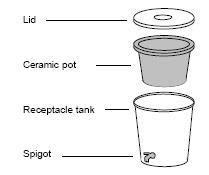
(added by Wretha-I assume they are talking about an unglazed ceramic pot, glazed pots are water proof and the water would not flow through)
2. Take Care to Avoid Cracks
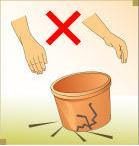 Handle the ceramic pot carefully to avoid breakage or cracking. Small invisible cracks may allow microorganisms to pass through the filter, making the water unsafe to drink.
Handle the ceramic pot carefully to avoid breakage or cracking. Small invisible cracks may allow microorganisms to pass through the filter, making the water unsafe to drink.
If a ceramic pot full of water takes less than 3 hours to empty, the flow rate is too fast and the ceramic pot should be replaced.
3. Before Using the Filter for the First Time
Soak the ceramic pot in clear water (rain or tubewell water) for 12 hours
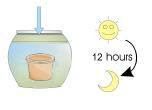
OR
Fill the ceramic pot three times, allow the water to seep through, and discard the filtered water.
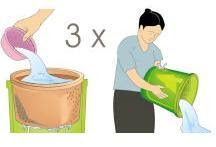
Doing one of the above two steps will flush the clay smell and color from the ceramic pot. You only need to do one of the above steps, it is not necessary to do both.
Lastly, clean the receptacle tank and spigot with soapy water. DO NOT use soap to clean the ceramic vessel.

4. Daily Use
Put the filter in a safe place where it will not get knocked over and secure it to the wall or a post.
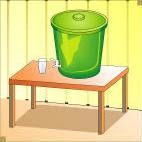
If the water source is very dirty, tie a piece of cloth over the top of the filter to strain out the dirt and debris.
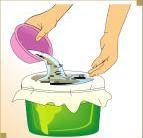
The filter will flow faster when the ceramic pot is full, so fill it often.

Keep the lid closed to prevent dust and mosquitoes from entering.

5. Cleaning the Filter
The ceramic pot should be cleaned once per month or when the flow rate begins to slow down.
– Clean the inside surface of the lid with soapy water and let it dry.
Place the lid on a level surface with the clean side facing up.
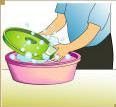
– Carefully lift the ceramic pot out of the receptacle and set it on the lid. Touch only the rim when lifting the ceramic pot.…
I got the Berkey water purifier in today, it got delivered to the country store, so that was a good excuse to go to the store. There were lots of people at the store, hanging around the porch, chatting. I showed everyone the filter, they were suitably impressed. Anyhoo, we brought it home, I took it to my neighbor’s house to clean it, it requires that you prep the filters, you backwash the filters to get out any loose carbon and such. When the water first came through the filter, it had an exothermic reaction, it got hot! Not too hot to hold, but it was definately hot, it immediately cooled down, I just wasn’t expecting it. :)
I packed it back in it’s box, took it to my house and set it up, it went together pretty easy, the only mistake I made was not making the nut tight enough on the spigot. That was easy enough to fix, I noticed a little water dripping from it, so I tightened it.
Next I poured a gallon of water in it, then I put a half a packet of grape flavored Koolaid in it, I didn’t have food coloring, I figured the Koolaid was the next best thing. It turned the water in the top a nice shade of grape scented purple water. The water immediately started dripping out of the filters, and it was clear, and non-scented. Once half of the water had gone through, I was satisfied both filters were working, so I poured the grape water out, and filled the top container with water. Since I had primed the filters, the water poured through pretty well at first, as the water level went down, the pressure dropped and the water slowed down, that is OK, it’s supposed to work that way.
I am very happy with my Berkey water purifier. It is money well spent! I give it 2 thumbs up.
 Anonymous said…
Anonymous said…We got our Berkey a few years ago and I love it!! It goes down in history as one of the best things I have spent money on. Congratulations!
Karen
May 9, 2008 9:03 AM
 Wretha said…
Wretha said…Thanks Karen, I really love mine, one of the hardest parts about it was deciding where to put it, we have VERY LIMITED space, every square inch has something sitting there already, we finally found a good place. We appreciate the fresh tasting, clean water we get out of it, my hubby has even been drinking PLAIN water, that has been nearly impossible before. :)
Wretha
May 9, 2008 10:22 AM
 Anonymous said…
Anonymous said…I’m sure you already know this link, but just in case you (or someone else reading this) doesn’t, the ‘rabbit’ water filter does a pretty good job as well.
https://pottersforpeace.org/wp-content/uploads/ide-filter-user-guide.pdf
I learned this one from Jim Dakin’s blog – thought it
Thanks for the additional links. Earlier I had read through the site and thought that to use the clay pot as a filter the pot needed to be one made by their people so one from the garden center would not work. Did I understand the different pages? Also, if one needs to use their pots, did you find an address or other contact info?
July 26, 2008 10:22 PM
Stephani, it would seem that the common garden center pots might not work, I went through their website to try to find out how to get a pot like they make, I don’t think it would be a good idea to ship them very long distances because of the possibility of breakage, even hairline cracks would be a problem. I am thinking about trying to find a “local” potter that could make a pot with the proper material and size. Don’t know how successful I’ll be, but if I find something, I’ll be sure to post about it here.
Wretha
July 26, 2008 11:05 PM